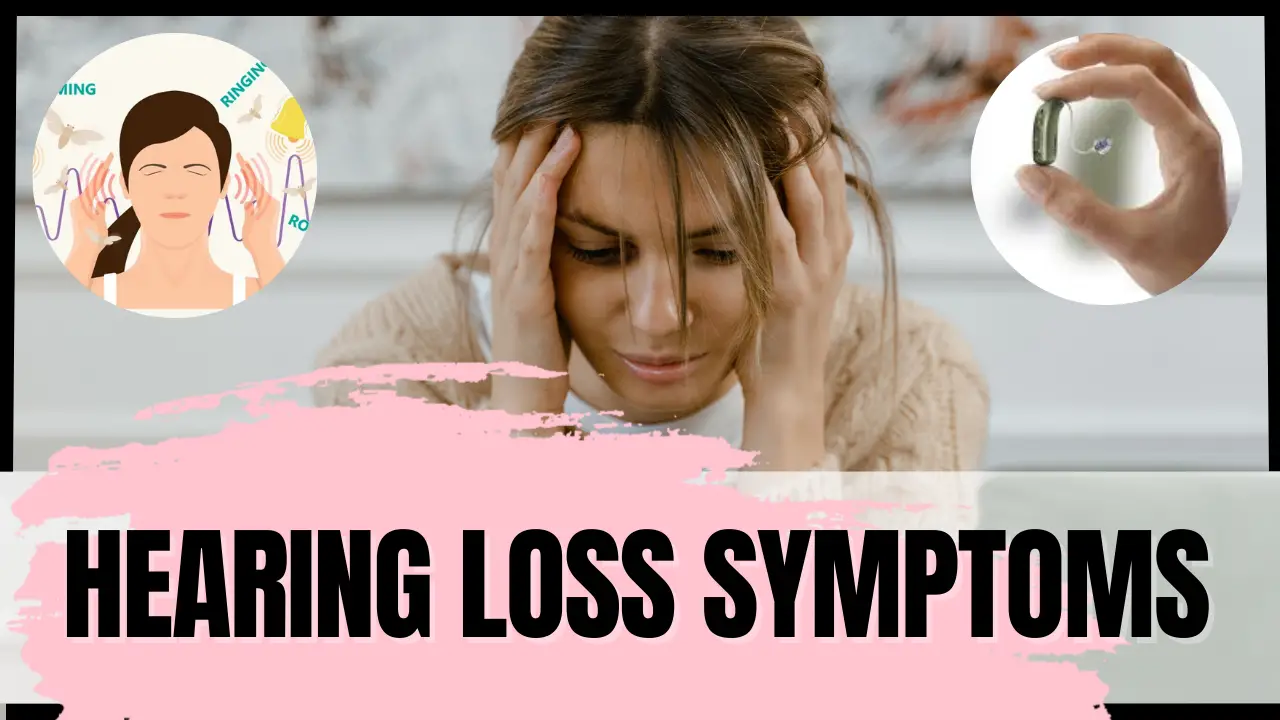Hearing Loss Symptoms should not be underestimated. Discover the typical signs, varieties, and causes of hearing loss, as well as how to identify it early on. You may also investigate available treatments and resources to help you take back control of your hearing health. Today, take control of your hearing!
Introduction:
The ability to hear is a fundamental sense that links us to the outside world and enables us to securely navigate our surroundings, enjoy music, and have conversations. But as they become older, a lot of individuals notice a gradual loss in their hearing, often without understanding the impacts until they become noticeable. Early detection of hearing loss is essential to minimize its effects and enhance your quality of life in general.
This tutorial explores the many forms of hearing loss, their causes, and the significance of early identification as it relates to typical symptoms. We’ll provide you with the information you need to evaluate your hearing and find the best resources for a diagnosis and course of treatment. Keep in mind that you are not alone if you experience hearing loss.
Understanding Hearing Loss:
Hearing loss is a complex condition that can manifest in different ways, depending on its type, severity, and underlying causes. Broadly categorized, hearing loss can be classified into three main types: conductive, sensorineural, and mixed hearing loss.
Conductive Hearing Loss:
Conductive hearing loss occurs when there is a problem with the outer or middle ear, hindering the transmission of sound waves to the inner ear. Common causes of conductive hearing loss include ear infections, earwax buildup, perforated eardrum, fluid accumulation in the middle ear, and abnormalities of the ear canal or middle ear bones (ossicles).
Symptoms of conductive hearing loss may include:
1. Difficulty hearing faint sounds or whispers.
2. Sensation of ear fullness or pressure.
3. Ear pain or discomfort.
4. Reduced ability to localize sounds.
5. Intermittent or fluctuating hearing loss.
Sensorineural Hearing Loss:
Sensorineural hearing loss results from damage to the inner ear (cochlea) or the auditory nerve pathways leading to the brain. This type of hearing loss is often irreversible and can be caused by aging (presbycusis), exposure to loud noise (noise-induced hearing loss), genetics, ototoxic medications, head trauma, or certain medical conditions like Meniere’s disease.
Symptoms of sensorineural hearing loss may include:
1. Difficulty understanding speech, especially in noisy environments.
2. Ringing, buzzing, or hissing sounds in one or both ears (tinnitus).
3. Reduced ability to hear high-frequency sounds.
4. Speech and sound distortion.
5. Sensitivity to loud noises (hyperacusis).
6. Gradual onset of hearing loss over time.
Mixed Hearing Loss:
Mixed hearing loss is a combination of conductive and sensorineural hearing loss, indicating impairment in both the middle and inner ear or auditory nerve. This type of hearing loss presents a combination of symptoms associated with conductive and sensorineural components.
Impact of Hearing Loss on Daily Life:
Hearing loss can significantly impact various aspects of an individual’s life, including communication, social interactions, emotional well-being, and overall quality of life. The following are ways in which hearing loss can affect daily life:

Communication Challenges:
1. Difficulty understanding speech, especially in noisy environments or group settings.
2. Strained conversations leading to miscommunication and frustration.
3. Need for repetition or clarification during conversations.
4. Inability to hear soft or subtle sounds, such as doorbells, phone notifications, or alarm clocks.
5. Challenges in following verbal instructions or participating in phone conversations.

Social and Emotional Impact:
1. Social withdrawal or isolation due to difficulty engaging in conversations or group activities.
2. Feelings of embarrassment, frustration, or inadequacy in social situations.
3. Negative impact on relationships with family, friends, and colleagues due to communication barriers.
4. Increased risk of depression, anxiety, and feelings of loneliness.
Professional and Academic Challenges:
1. Difficulty participating in meetings, lectures, or classroom discussions.
2. Reduced job performance or academic achievement due to communication barriers.
3. Impact on career advancement opportunities or educational outcomes.
Physical and Cognitive Strain:
1. Increased cognitive load and mental fatigue from the constant effort to hear and understand speech.
2. Strain on interpersonal relationships due to communication challenges.
3. Potential safety risks from not hearing important environmental cues or warnings.
Early Signs and Hearing Loss Symptoms:
Recognizing the early signs and symptoms of hearing loss is crucial for timely intervention and management. While the symptoms may vary depending on the type and severity of hearing loss, common early indicators include:
1. Difficulty hearing in noisy environments or group settings.
2. Asking others to repeat themselves frequently.
3. Turning up the volume on electronic devices such as the television or radio.
4. Withdrawal from social activities or avoidance of group gatherings.
5. Ringing, buzzing, or hissing sounds in the ears (tinnitus).
6. Feeling that others are mumbling or not speaking clearly.
7. Ear pain, pressure, or discomfort.
Diagnosis and Treatment:

If you or someone you know experiences any of the aforementioned symptoms, it’s essential to seek a comprehensive hearing evaluation from a qualified audiologist or hearing healthcare professional. The diagnostic process typically includes a series of tests to assess hearing sensitivity, speech understanding, and the underlying cause of hearing loss.
Diagnostic Tests:
1. Pure-tone audiometry: Measures hearing sensitivity across different frequencies.
2. Speech audiometry: Evaluates speech understanding in quiet and noisy environments.
3. Tympanometry: Assesses the function of the middle ear and mobility of the eardrum.
4. Otoacoustic emissions (OAEs): Measures the response of the inner ear (cochlea) to sound stimulation.
5. Auditory brainstem response (ABR) testing: Evaluates the function of the auditory nerve pathways.
Once the type and severity of hearing loss are determined, the audiologist will recommend appropriate treatment options, which may include:
1. Hearing Aids:
Hearing aids are electronic devices worn in or behind the ear to amplify sound and improve hearing sensitivity. Modern hearing aids are available in various styles, including behind-the-ear (BTE), in-the-ear (ITE), completely-in-the-canal (CIC), and invisible-in-canal (IIC) options.
2. Cochlear Implants:
Cochlear implants are surgically implanted electronic devices designed to bypass damaged hair cells in the inner ear and stimulate the auditory nerve directly. They are typically recommended for individuals with severe to profound sensorineural hearing loss who do not benefit from conventional hearing aids.
3. Assistive Listening Devices (ALDs):
ALDs are specialized devices designed to enhance communication in specific listening situations. Examples include FM systems, infrared systems, loop systems, and personal amplifiers.
4. Communication Strategies and Rehabilitation:
Hearing healthcare professionals can provide counseling, communication strategies, and auditory training to help individuals with hearing loss maximize their communication abilities and adapt to their hearing devices effectively.
5. Medical or Surgical Intervention:
In some cases, medical or surgical intervention may be necessary to address underlying causes of hearing loss, such as ear infections, perforated eardrum, or otosclerosis.
Prevention Strategies On Hearing Loss Symptoms
While some causes of hearing loss are unavoidable, there are several preventive measures individuals can take to protect their hearing health:
1. Avoid exposure to loud noises:
Limit exposure to loud sounds, such as concerts, sporting events, power tools, and firearms. Use earplugs or earmuffs in noisy environments.
2. Practice good ear hygiene:
Avoid inserting foreign objects into the ear canal and clean ears gently using a damp cloth.
3. Monitor medication side effects:
Be aware of medications that can cause ototoxicity (damage to the inner ear), and discuss alternative options with healthcare providers if necessary.
4. Get regular hearing screenings:
Schedule routine hearing evaluations, especially if you notice any changes in your hearing or experience symptoms of hearing loss
5. Maintain overall health:
Adopt a healthy lifestyle that includes regular exercise, balanced nutrition, and proper management of underlying medical conditions that may affect hearing health.
Conclusion:
A common condition that may significantly affect several aspects of everyday living, such as social relationships, communication, emotional health, and general quality of life, is hearing loss. Early detection of hearing loss symptoms is essential for prompt treatment and intervention. Being aware of the warning signs and symptoms, such as trouble comprehending speech, ringing in the ears, or social disengagement, can empower people to take proactive measures for improved hearing health. Do not hesitate to seek the assessment and treatment of a trained hearing healthcare expert if you or someone you know is experiencing any signs of hearing loss. People with hearing loss may have happy, meaningful lives if they receive the right care and assistance.
FAQ’s
1. What are the most common symptoms of hearing loss?
Hearing loss can manifest in various ways, but some common symptoms include:
- Difficulty hearing conversations, especially in noisy environments.
- Needing to ask people to repeat themselves often.
- Turning up the volume on devices like TVs or phones more than usual.
- Muffled or distorted sounds.
- Trouble hearing high-pitched sounds, like children’s voices or birds singing.
- Tinnitus (ringing or buzzing in the ears).
2. How can I tell if I have hearing loss or it’s just normal aging?
While some hearing loss is expected with age, it’s essential to differentiate between normal age-related decline and something more concerning. If you experience any of the symptoms mentioned above, especially if they’re progressively worsening, it’s best to consult a doctor or audiologist for a proper evaluation.
3. Do certain sounds always indicate hearing loss (e.g., muffled voices, high-pitched noises)?
While muffled voices and difficulty hearing high-pitched sounds can be symptoms of hearing loss, they might also be caused by temporary factors like earwax buildup or ear infections. However, if these issues persist or come with other symptoms, seeking professional advice is crucial.
4. Is there a difference between temporary and permanent hearing loss?
Yes, there are two main types of hearing loss: temporary and permanent. Temporary hearing loss can be caused by various factors like ear infections, loud noise exposure, or earwax buildup. It usually resolves on its own or with treatment. Permanent hearing loss, on the other hand, arises from damage to the inner ear or auditory nerve and typically doesn’t improve without intervention like hearing aids or cochlear implants.
5. Should I see a doctor if I suspect hearing loss? What tests will they perform?
If you have any concerns about your hearing, visiting a doctor or audiologist is highly recommended. They can perform various tests to assess your hearing ability, including:
- Pure tone audiometry: This test measures how well you hear different frequencies of sound.
- Tympanometry: This test evaluates the middle ear function.
- Speech audiometry: This test assesses your ability to understand spoken words.
Early diagnosis and intervention are key to managing hearing loss effectively. Don’t hesitate to seek professional help if you suspect any issues.
You can read more for solutions:

